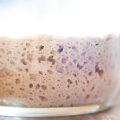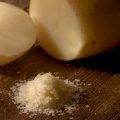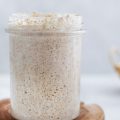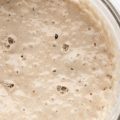During the process of making sourdough bread and feeding your sourdough starter, you may have noticed a little liquid collecting along with your starter. It may seem like the flour and water have separated, but this is actually normal. This sourdough starter liquid is called hooch, and this normally occurs once your starter has consumed all of its available food. But if you’re still a little concerned about what this is, let’s delve deeper into it and ease your mind!

Table of Contents
- What is Hooch?
- Causes of Hooch Formation
- Identifying Healthy vs. Problematic Hooch
- What to Do with Hooch
- Why Does my Sourdough Starter Have Liquid?
- Should I Get Rid of the Hooch?
- What Color is Hooch?
- How to Prevent Hooch From Appearing?
- How to Make the Perfect Sourdough Starter?
- What to do if my Starter is too Runny?
- How to Refresh my Sourdough Starter?
- How do I Know When my Sourdough Starter is Ready to Use?
- The Correct Way to Feed my Sourdough Starter
- Common Starter Mistakes
- So About the Liquid on my Sourdough Starter?
- FAQs
What is Hooch?
Ever peeked under the lid of your sourdough starter jar and spotted a mysterious liquid hanging out on top? Don’t panic! You’ve just met hooch, your starter’s boozy little friend.
Hooch is basically your sourdough starter’s way of saying, “Hey, I’m hungry!” This liquid layer forms when the hungry yeast and bacteria in your starter have gobbled up all their available food and are looking for their next meal.
Think of it like the rumbling tummy of your sourdough pet. It’s a sign that fermentation is happening, but your starter needs a little TLC (and by TLC, I mean flour).
Hooch isn’t just any old liquid – it’s a fermentation party in a puddle! Here’s what’s going on:
- Alcohol: Yep, there’s a tiny bit of booze in there. The yeast produces alcohol as it ferments the flour.
- Acetic acid: This gives hooch (and your bread) that trademark tangy flavor.
- Water: The liquid part comes from moisture in your starter separating out.
Your starter is a living ecosystem of yeast and bacteria. When they run out of food (flour), they start producing more alcohol and acid. This process, along with the lack of fresh flour to absorb moisture, leads to liquid separation.
Hooch is more likely to form if:
- Your starter is hungry (time to feed!)
- The environment is too warm (yeast party too hard)
- Your starter is a bit neglected (we’ve all been there)
Causes of Hooch Formation
The Feeding Frenzy (or Lack Thereof)
Ever wondered why your sourdough starter sometimes looks like it’s trying to brew its own beer? Let’s dive into the world of hooch formation and uncover the culprits behind this boozy phenomenon.
First things first: your starter’s eating habits play a huge role. Think of your starter like a hangry teenager – too little food, and it’ll start causing trouble.
- Underfeeding: Skip a few meals, and your starter will start producing hooch faster than you can say “sourdough.” When there’s not enough fresh flour to munch on, the yeasts and bacteria get desperate and start fermenting whatever’s left, leading to that telltale liquid layer.
- Overfeeding: Surprisingly, too much food can also lead to hooch. If you’re dumping in flour like there’s no tomorrow, your starter might not be able to keep up. The result? Unused flour starts fermenting, and boom – hooch city.
Temperature Tantrums
Your starter isn’t just picky about its meals – it’s also a bit of a temperature diva.
- Crank up the heat, and your starter will go into overdrive. Higher temperatures speed up fermentation, which means your starter burns through its food supply faster. Before you know it, you’ve got a pool of hooch on your hands.
- On the flip side, if your kitchen’s giving off igloo vibes, your starter might slow down to a crawl. This can lead to inconsistent fermentation and, you guessed it, hooch formation.
Activity Levels: The Sourdough Workout
Your starter’s fitness level also plays a part in hooch production.
- Lazy Starter: If your starter’s been chilling in the fridge for a while, it might need some time to get back in shape. During this warm-up period, you might see more hooch as it struggles to find its rhythm.
- Hyperactive Starter: Sometimes, a super active starter can burn through its food too quickly, leading to hooch formation. It’s like a sourdough marathon runner hitting the wall – they need constant refueling to keep going.

Identifying Healthy vs. Problematic Hooch
How do you know if it’s just your starter’s way of saying “Feed me!” or if something’s gone seriously wrong?
Color. Healthy hooch typically ranges from clear to slightly amber. Clear indicates a well-fed starter, while amber suggests it’s getting hungry. As long as you’re in this color spectrum, you’re generally in the clear.
Smell is another important indicator. A healthy starter should have a familiar tangy, fermented aroma. If your nose picks up notes of sourdough bread or even a slightly boozy scent, you’re on the right track. This indicates normal fermentation is occurring.
Now, let’s talk about when things go south. If your hooch starts looking concerning, it’s time to pay attention.
Dark brown or black hooch indicates your starter has been neglected for too long. While it might not mean your starter is completely ruined, it’s definitely time for some extra care and attention.
And let’s not forget about the smell. If your starter starts giving off unpleasant odors, that’s a problem. Foul, putrid, or just plain bad smells are a sign something’s wrong. Trust your nose in these situations.
Here’s where things get serious. If you spot any fuzzy growths, colorful patches, or anything that looks like mold, it’s time to discard your starter. Mold is a deal-breaker in the sourdough world, and there’s no salvaging a moldy starter. When in doubt, throw it out!
What to Do with Hooch
There are several ways to handle this situation effectively.
The Great Stir-In Debate
The first option is to stir the hooch back into the starter. Many experienced bakers prefer this method. Stirring the hooch in can help reinvigorate your starter and maintain the complex flavors you’ve developed over time.
However, if your starter has been neglected for a while, the hooch might be too strong. In such cases, you might want to consider an alternative approach.
The Pour-Off Method
For starters that have been left unattended for an extended period, pouring off the hooch can be beneficial. This is particularly useful if there’s an excessive amount of hooch or if it looks unusually dark or has an off-putting odor.
Keep in mind that removing hooch will affect your starter’s hydration. You may need to adjust your next feeding to restore the proper balance of flour and water.
Feeding Frenzy: Adjusting Your Schedule
The most effective way to manage hooch is to prevent its formation in the first place. This primarily involves optimizing your feeding routine. If you consistently see hooch appearing, it’s a clear sign that your starter needs more frequent feedings.
Consider increasing your feeding frequency. For instance, if you’ve been feeding once a day, try switching to twice-daily feedings. If that’s not feasible with your schedule, you could reduce the amount you feed at each feeding but increase the frequency.
The Goldilocks Zone: Temperature Matters
Temperature plays a crucial role in hooch formation. If the environment is too warm, your starter will consume its food supply more quickly, leading to more hooch production. Conversely, if it’s too cold, the starter’s activity will slow down significantly.
Aim for a temperature around 70°F (21°C), which is generally ideal for most sourdough starters. This helps maintain a balanced rate of fermentation and can help control hooch production.
Why Does my Sourdough Starter Have Liquid?
If you are an avid sourdough baker, then you may have noticed that your starter has formed a little pool of liquid on top of it. Some people call this hooch, and others call it alcohol. The truth is that hooch is actually the by-product of fermentation and in no way should be consumed because it contains alcohol.
It’s important to understand what this slightly sticky liquid forming on top of your starter is, and whether it is here to stay!
Let’s start with the basics: in its simplest form, your sourdough starter is just flour and water – and a bit of salt if you’re using some. The flour contains starches that when combined with water begin fermenting under certain conditions. This process is called leavening and produces carbon dioxide bubbles, which give bread its characteristic airy texture.
You’ve probably seen this happening before, when you’ve tried making homemade bread; sometimes though instead of creating bubbles within the dough itself (resulting in lighter bread), fermentation can cause bubbles outside of your dough too! When there isn’t enough food left for your yeast cells to eat up all their food quickly enough, some will remain hungry. These cells will then begin consuming any available sugars left in order to survive until they can be fed again later on.
Should I Get Rid of the Hooch?
You may have heard that hooch is bad for you and your starter. Well, that’s not entirely true. In fact, it’s quite good.
Hooch gives your starter it’s distinct tangy flavor and helps to produce even more sourness in the final loaf of bread.
If you do choose to discard some liquid from your sourdough starter, it’s important to remember that this will change the hydration of the remaining mixture. So try not to go overboard when doing so!
If your sourdough has formed its little puddle of liquid, mix it back into the starter before discarding a little bit of the starter in time to feed.
The only time we recommend getting rid of hooch from your sourdough is if it has been stored in the fridge for a long time – like months or years – and there is an abundance of dark brownish colored liquid on top, which can indicate mold growth.
What Color is Hooch?
The color of your hooch will depend on the kind of starter you are using. A very young sourdough starter will have a clear or slightly cloudy liquid on top, while a more mature one may have a black or purple liquid sitting atop the dough.
This is quite normal, and won’t affect the performance of your starter. Although you may want to refrain from allowing it to become more darker. Simply stir in the liquid and discard before feeding again.
If you see a mold growing on top of your starter, then it’s time to discard that batch and start again with fresh ingredients.
How to Prevent Hooch From Appearing?
If your starter is consistently producing hooch, even after it has been fed, you may need to change a few things.
Hooch may be harmless, but it is an indication that your starter is hungry, meaning that you’ll need to increase its food, and stop it from consuming it so quickly.
To tackle this, try increasing the regularity of feeding, so instead of feeding your starter every 24 hours, attempt to feed your starter after 12 hours. If this doesn’t work and the hooch still appears in excess amounts then try moving your starter to a cooler spot and maintaining a temperature of 70 °F or lower. This will hopefully ensure that it consumes its feed slower.
Feeding at a higher ratio of flour and water may also contribute; try increasing the flour by 10% each time until no more hooch appears on top of the sourdough starter.
How to Make the Perfect Sourdough Starter?
Once you have your sourdough starter, it’s important to keep feeding and maintaining it.
First, take out a few tablespoons of the starter and mix them with equal amounts of flour and water. Then, place the mixture in a glass jar with an airtight lid. Follow with covering loosely using a towel or cheesecloth (this will help keep flies away).
In order to maintain proper moisture levels for your starter, keep an eye on its consistency. Add more water when necessary to ensure that it remains nice and loose.
Take enough care of your starter so that your it begins to showcase these signs:
- Your starter should appear bubbly, active and release a sour smell. It should also be able to hold its shape.
- Your starter should be able to double in size overnight.
Furthermore, you should ensure that your starter is fed regularly. Feeding should be done after every use of the sourdough, whether it is used daily or once a week.
What to do if my Starter is too Runny?
If your starter is too runny, it may prevent your starter from growing, and rising. The gas bubbles rapidly escape through the runny liquid, and not through the top layer of flour, as they should.
This is often caused by using a different type of flour with a different type of gluten than what is normally used for sourdough starter. Essentially, using very hot or cold water when making your next batch of sourdough bread can also result in a very runny starter. The best way to revive a runny starter is through discarding most of it and leaving a tiny amount in the jar.
Use a spatula to scrape all the remains of your sourdough starter out of its container, place it in a clean jar, then add 20g of wholemeal flour and 20g of water. Mix thoroughly with the remaining old starter until a smooth paste forms. Add some more water if necessary until the correct consistency is achieved. There should be no dry crumbs left at the bottom.
Clean off the sides of the jar with a spatula and leave it on a countertop with a loose lid for 6-12 hours. After this time some activity should have occurred within the jar, meaning that your starter has successfully revived!
For some tips on troubleshooting sourdough starter that doesn’t provide that perfect rise you seek, check out our blog: Sourdough Not Rising – What Went Wrong and How to Fix it.
How to Refresh my Sourdough Starter?
Refreshing your sourdough starter can be done in a variety of ways.
One method is to remove 1/4 of the starter and add 1/4 flour and 1/4 water, then place it back in with the remaining starter for 24 hours. Once this period has elapsed, feed again with 1/4 flour and 1/4 water.
Another common method, is to discard all but about an ounce or so of your current sourdough starter, which will still have plenty of life left, add new flour, water and salt and let it sit out overnight at room temperature. Then feed your starter once again with equal parts new flour, water and salt before returning it to its container.
How do I Know When my Sourdough Starter is Ready to Use?
You may have noticed, but there are a few things that can help you know when your sourdough starter is ready to use.
First of all, look at the jar or container that you are using. You will see bubbles on the surface and sides of your starter. The bubbles mean that it has risen up with carbon dioxide gas and this means that it is ready for use.
The second thing to look out for is how long it takes for your starter to double in size. This should take anywhere between 12-24 hours if everything goes according to plan. If this happens within 12 hours then you needn’t worry anymore, because something went wrong somewhere along the way. It has resulted in an overall problem in the sourdough starter recipe!
The Correct Way to Feed my Sourdough Starter
The best way to start feeding your sourdough starter is with equal parts flour and water. Once you’ve mixed these ingredients together, cover the bowl with a clean cloth and let it sit for 8 hours at room temperature.
After you have given your starter its initial feeding, check on it after 8 hours. If there’s still liquid on top of the dough, don’t worry! This is a sign that your sourdough is working properly. Just give it another hour or so until all of the liquid is absorbed into the dough.
If in doubt, stick around. You’ll know when it’s time to move on because there will be no more wet spots visible on top of your starter, instead, there should be lots of little bubbles throughout!

Common Starter Mistakes
It’s easy to get carried away and shower your starter with more love (read: flour) than it needs. But here’s the thing: overfeeding can be just as problematic as underfeeding. When you dump in too much flour, your starter might struggle to ferment it all, leading to a soupy mess or, you guessed it, more hooch.
To avoid this feeding frenzy, stick to a consistent schedule and ratio. A good rule of thumb? Feed your starter twice its weight. So if you’ve got 50g of starter, add 50g each of flour and water. It’s like portion control for your sourdough pet!
Your starter isn’t just picky about its meals; it’s also particular about its living quarters. Stashing your starter in a spot that’s too warm is like sending it on a tropical vacation – it’ll party hard, eat through its food supply quickly, and before you know it, you’re dealing with hooch city.
On the flip side, relegating your starter to the chilly depths of your fridge without proper preparation is like forcing it into hibernation. It’ll slow down to a crawl, potentially leading to inconsistent fermentation and – you guessed it – more hooch.
The sweet spot? Aim for room temperature, around 70°F (21°C). If you’re dealing with a particularly warm kitchen (hello, summer baking!), consider finding a cooler spot or even using a proofing box to maintain that perfect temp.
Let’s be real – we’ve all been guilty of neglecting our starters at some point. Life gets busy, and suddenly that jar of bubbly goodness has been sitting untouched for weeks. But here’s the hard truth: a neglected starter is an unhappy starter, and an unhappy starter produces more hooch than bread.
To avoid this, set reminders if you need to. Treat your starter like a pet – it needs regular feeding and attention. If you know you’ll be away or too busy to maintain it daily, consider giving it a hearty feed and popping it in the fridge. It’ll slow down the fermentation process, buying you some time before your next feeding.
So About the Liquid on my Sourdough Starter?
Coming down to check on your starter in the morning? Find a little liquid forming on top? It’s not a cause for concern.
Unless there is mold involved, you do not need to get rid of the hooch. In fact this little pool of dark liquid is what provides your sourdough loaves with its perfected tanginess!
FAQs
Should I Pour the Liquid off my Sourdough Starter?
Generally, you shouldn’t remove the liquid (or hooch) off of your sourdough starter. This becomes a part of your sourdough starters hydration, and pouring it off will jeopardize the hydration of your starter.
Can You Drink Sourdough Starter Hooch?
Generally, the hooch that forms on top of your sourdough starter is harmless. However it isn’t recommended to drink it directly, but you can use it to make beer, wine etc.
How do You Know if Sourdough Starter is Bad?
You can tell that your sourdough starter has gone bad if it doesn’t respond to regular feedings, especially if it has been left unfed for a long period. Other signs can include discoloration and mold, which would indicate that it’s time to throw it out and start over.

![Sourdough Starter Temperature [Beginner'S Guide] 7 Sourdough starter temperature [a beginner’s guide]](https://www.mydailysourdoughbread.com/wp-content/uploads/2023/01/blog-images-48-120x120.jpg)




